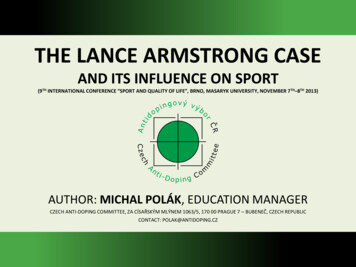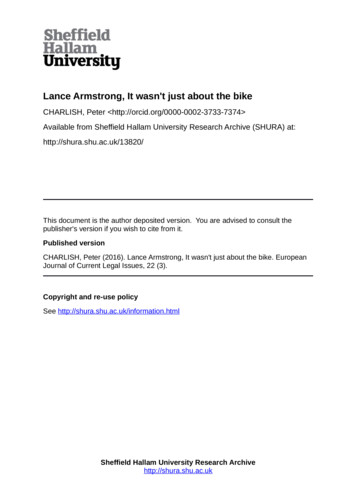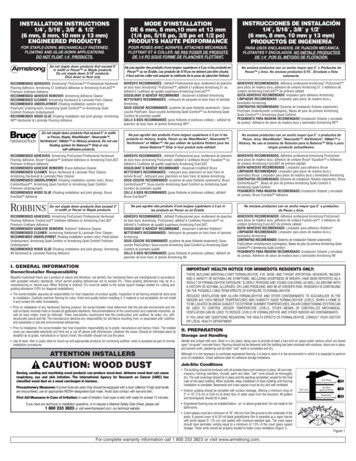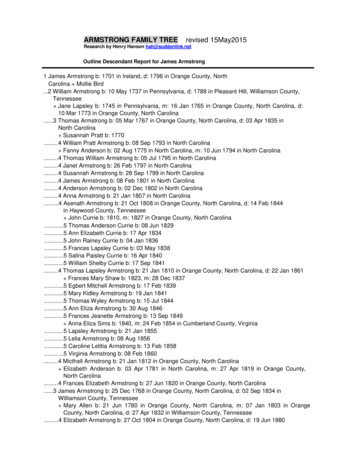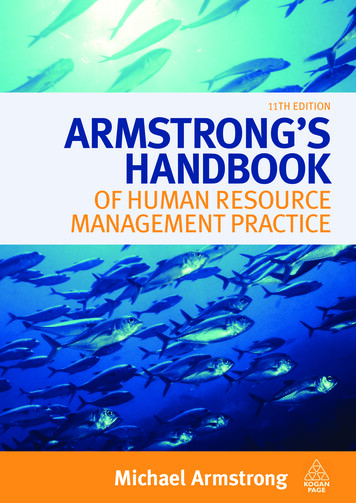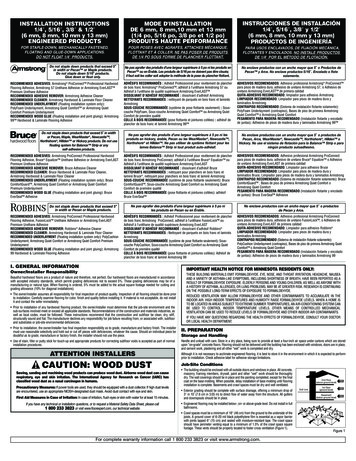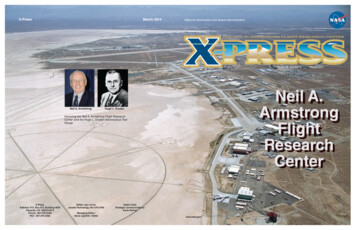
Transcription
Lance Armstrong: A Greedy Doper or an Innocent Victim?“When the doctor asked if he’d [Armstrong] ever used performance-enhancing drugs,Lance answered, in a matter-of-fact tone, yes. He’d used EPO, cortisone, testosterone, humangrowth hormone, and steroids” (Hamilton, Coyle, 2012). This incident was widely described inFrankie Andreu’s affidavit in the USADA document, and is supposed to have happened in thefall of 1996 when Armstrong was diagnosed with cancer. What Tyler Hamilton (one ofArmstrong’s former teammates) stresses in the next few lines of his statement is the opennesswith which Armstrong used to talk about doping and his involvement in the process: “He wantsto minimize doping, show it’s no big deal, show that he’s bigger than any syringe or pill.”Hamilton makes a statement that Armstrong is “cavalier about doping” and had never reallycared to hide his susceptibility to doping. Obviously, Lance Armstrong denies that any of theabove mentioned situations had ever happened. Someone must be lying then. Based solely onone person’s words against another person’s words, it is impossible to verify who the liar is.Therefore, Armstrong’s case needs thorough and honest research, and evaluation ofcircumstantial evidence, taking into account both sides of the argument.On Saturday, November 10th, Lance Armstrong released a photo of himself resting in theliving room of his house in Austin, TX, while admiring his seven Tour de France yellow jerseyshanging on the walls. The yellow jerseys stand for the Tour de France titles of which LanceArmstrong has just recently been stripped. By doing so, Armstrong seems to be provoking afurther discussion on his doping case. He wants his fans to keep faith in him and not believe theaccusations. This is how he plays this game. He has not given up yet. Nevertheless on Thursday,Maciek RomanowiczPage 1
November 15th, the Livestrong Foundation removed Lance Armstrong’s name from its title. Bydoing so the Foundation wished “to separate the organization from the identity of its founder”(Albergotti, 2012). But this move may also be interpreted as following the crowd as more andmore people are turning their backs on Lance Armstrong because they don’t believe himanymore. It is worth remembering the fact that in the wake of the doping scandal all ofArmstrong’s major sponsors left him. Similarly, “Tufts University in Massachusetts rescindedLance Armstrong’s honorary degree” ("Armstrong loses degree," 2012) because, as Tufts’ boardof trustees claims, Armstrong’s “actions as an athlete are inconsistent with the values of theuniversity” (quoted in: "Armstrong loses degree," 2012). Such mass desertion from Armstrongcould not have occurred based solely on assumptions. Since people who had been affiliatedwith Armstrong for a long time are abandoning him, the implicit answer to the questionwhether Lance Armstrong had doped or not is becoming clearer.“If you shut up the truth and bury it under the ground, it will but grow and gather itselfsuch explosive power that the day it bursts through it will blow up everything in its way” –these are the words once uttered by Emile Zola. Tyler Hamilton uses this quotation to serve as amotto for his book entitled The Secret Race. Hamilton treats the book as his confession. Hedescribes where, when and how he had doped during his career. The specific situationsHamilton describes often involve Lance Armstrong, since they frequently cooperated with eachother, both when biking and when doping. Daniel Coyle, the coauthor of The Secret Race,interviewed Hamilton for more than two years and helped Hamilton put his cycling experience(including doping) into words. In the “Story behind this book,” which serves as a foreword toThe Secret Race, Daniel Coyle states that back in 2005 he “was 50-50 on the question [aboutMaciek RomanowiczPage 2
Armstrong’s doping], with the likelihood rising steadily as time passed” (Hamilton, 2012). Thatwas right after he had written glorifying Lance Armstrong's War: One Man's Battle Against Fate,Fame, Love, Death, Scandal, and a Few Other Rivals on the Road to the Tour de France (2005)which “several of Armstrong’s teammates judged to be objective and fair” (Hamilton, 2012).Coyle’s desire to write another book on cycling and doping came in May 2010 when an agent,Jeff Novitzky, started his own investigation of Armstrong. Coyle knew Tyler Hamilton becausehe had interviewed him earlier for the needs of Lance Armstrong’s War. Coyle also knew thatHamilton did not pass the Olympics’ doping test in 2004 and therefore was banned from thesport for two years. This is how these two started to cooperate and created the work that brokethe omerta1 code in the cycling world.In one of the first only-truth interviews with Coyle, Hamilton says:They [prosecutors in the courtroom in Los Angeles] kept asking me about Lance – theywanted me to point finger at him. But I always pointed it at myself first. I made themunderstand how the whole system worked, got developed over the years, and how youcouldn’t single out one person. It was everybody. Everybody. (Hamilton, 2012)As Coyle stresses, Hamilton’s decision to testify in Armstrong’s case was not intended to ruinthe legend. Hamilton’s only motivation was to finally scream out loud the aching truth.Similarly, in a book written by John Wilcockson Lance: The Making of the World’s GreatestChampion, an attentive reader may find inconsistency and denial to the title of the book. In thebook a cycling expert, Len Pettyjohn says: “If somehow they [Lance Armstrong and Greg1Omerta – is a popular code of honor among particular groups of people which includes “code of silence” andunwillingness to collaborate with the authorities.Maciek RomanowiczPage 3
LeMond2] ended up in a drug culture, with other people, they were still better. It doesn’t takeaway from their accomplishments at all” (Wilcockson, 2009). When a reader first sees thisquotation he/she may consider it a joke. How could the alleged world’s greatest champion,Lance Armstrong, have ever been involved in the drug environment? By providing suchquotations, Wilcockson unintentionally defines his book as one-sided. Building on that, his booklacks credibility, because the world’s greatest champion is supposed to be as clean as a whistle.Therefore the widespread drug culture in cycling during his era (20 out of 21 podium finishers“have been directly tied to likely doping” (USADA, 2012)) cannot serve as an excuse forArmstrong.How had Armstrong avoided being caught red-handed throughout his career if he haddoped continuously? Hamilton’s answer to that question is as simple as it could only be: “Thetests are easy to beat. We’re way, way ahead of the tests. They’ve got their doctors, and we’vegot ours, and ours are better.” Here, Hamilton not only provides an answer to the question howArmstrong was able to evade detection, but also may explain why the problem of doping existsin the world of sport. Moreover, Hamilton goes even a little bit further in his claims: “Besides,the UCI [Union Cycliste Internationale, the sport’s governing body] doesn’t want to catchcertain guys anyway. Why would they? It’d cost them money” (Hamilton, 2012). In other words,most sports’ governing bodies are crooked and also full of liars who are only dedicated to onegoal: make as much money as possible in the fastest (and at the same time most dishonest)possible way. The officials’ approach may be compared to Machiavellianism in which endjustifies the means.2Greg LeMond – an American ex-cyclist who won three Tour de France titlesMaciek RomanowiczPage 4
Lance Armstrong has a very strong personality and a great ability to hide the truth.Nevertheless, Tyler Hamilton “can feel for Lance” (Hamilton, 2012). “Now he [Armstrong] hasno choice. He has to keep lying, to keep trying to convince people to move on. He can’t go back.He can’t tell the truth. He’s trapped.” As much as it may explain why Armstrong still denies theaccusations, it does not help to solve the Armstrong problem. In Lance Armstrong’s War, Coylecites Armstrong’s chiropractor: “You could give him [Armstrong] the most horrible news. Andhe would be able to absorb it, deal with it, and move past it very quickly and never, ever goback to it” (Coyle, 2004). Probably the same thing happens with the doping allegations. Theirfallout, such as stripping Armstrong of all seven Tour de France victories, should be the“horrible news” for Armstrong but he does not seem to have lost his peace of mind when heacts and lies in public.But what happens behind the scenes is a different story. Tyler Hamilton in his bookdescribes the situation, which took place in June, 2011 after Hamilton revealed the truth aboutdoping in cycling in the “60 minutes” report one month earlier. In an incident, which Hamiltonthought was a coincidence, but which later turned out to have been planned by Armstrong,Hamilton met Armstrong in a restaurant called “Cache Cache” in Aspen. According to Hamilton,Lance Armstrong threatened Hamilton saying: “I am going to make your life a living fu**ing hell” (Hamilton, 2012). That only shows that Armstrong is actually worried that the publicopinion would start to believe the accusations leveled against him, and he is not as coldblooded as he appears to be.Maciek RomanowiczPage 5
After Armstrong’s last Tour de France victory in 2005 he said: “I am sorry you can’tdream,” (Wilcockson, 2009) addressing all the people who had always tried to associateArmstrong with doping. By voicing such statements Armstrong tries to point to his extremelyhard work and ability to dream big as main ingredients of his success. But what if thosedoubters cannot dream because of the cheaters they are surrounded by? What about the cleancyclists’ (and athletes overall) dreams? Was Armstrong permitted by the heavens to take theirgoals and desires away?It is the code of silence (omerta) that used to safeguard the doping system duringArmstrong’s era. Worth mentioning is a case between Lance Armstrong and SCA Promotions3 in2005 after Armstrong’s last Tour de France victory. The story is widely described inWilcockson’s book. The company was supposed to pay Armstrong a few millions dollars as abonus for his Tour de France win. But SCA Promotions did not intend to pay because of thedoping allegations that were floating around Armstrong. The dispute ended in court and SCAlost the trial. It is relevant to stress that only one person broke the “code of silence” at thattime and it was Frankie Andreu’s wife, Betsy, who “was opposed to doping, and whenever shewas around the conversation could not go to doping” (Hamilton, 2012). In her affidavit shetestified that in the hospital room when Armstrong was struggling with cancer (in 1996) “sheoverheard him [Armstrong] tell a doctor that EPO was one of several performance-enhancingdrugs he [Armstrong] had taken in the past.” As mentioned earlier, this incident was alsodescribed by Tyler Hamilton in his book The Secret Race. The only difference was that more3SCA Promotions is an insurance company which provides promotional solutions and incentives to its clients.Lance Armstrong used to be its clientMaciek RomanowiczPage 6
people supposedly broke the omerta code and spoke about this incident also in their affidavitsfor the USADA report. Worth acknowledging is the fact that Lance Armstrong had nevermentioned the “hospital room” (Walsh, 2007) incident in his autobiography entitled It’s NotAbout the Bike: My Journey Back to Life.The description of the “hospital room” (Walsh, 2007) conversation also may help tounderstand Armstrong’s self-centered life built on lies. An account of the incident can be foundin David Walsh’s book entitled From Lance to Landis: Inside the American Doping Controversy atThe Tour de France as well and it is word for word exactly the same as Tyler Hamilton’sdescription in The Secret Race. Walsh also makes a point that Armstrong denied that such asituation had ever happened, claiming that the doctors had never asked him about hisapproach to doping. Needless to say, Walsh was the first prominent writer to throw somedoubts on Armstrong’s success. His first book, L.A. Confidential: Lance Armstrong’s Secrets,which he coauthored with Pierre Ballester, was published in 2004. It was based on theinterviews with Emma O’Reilly, Armstrong’s massage therapist back in 1999. At that time, shewas the first to break the omerta code in the cycling world. Her affidavit is now a part of theUSADA document. In the article that appeared in Sports Illustrated on October 22, 2012, Walshrecalls an unpleasant incident from the 2004 Tour de France. He asked a British journalist (hedoes not mention his name but one can conclude from the article that it was John Wilcockson,the author of Lance: The Making of the World’s Greatest Champion) for a ride, as they hadalways been good friends. Instead of a welcome invitation, Walsh got rejected. It was obviousto him that after his watchdog style L.A. Confidential had been published he was consideredpersona non-grata among Lance’s lapdog journalists, such as Wilcockson. Lance Armstrong wasMaciek RomanowiczPage 7
not any nicer. After Walsh’s breakthrough book, Lance Armstrong has always referred to him asa “the little fu**ing troll” (Walsh, 2012) who would do everything to destroy Armstrong’sperfect world of lies. This quotation reveals Armstrong’s self-centered, real personality.But Armstrong’s ego seems to have diminished. Recently, he decided not to fight thedoping allegations. He gave up the struggle. “If I quit, however, it lasts forever. That surrender,even the smallest act of giving up, stays with me” (Armstrong, 2001), and so the dopingallegations stay with him. He lost the war, although he had won several small battles before(many lawsuits against a number of people who associated Armstrong with doping). In thewake of new evidence released by USADA on October 10, 2012, it looks like he had won thosecourt battles playing a no-holds-barred game of lies. But he has just been stripped of all glorythat he “fought so hard for.” During his career he was smarter than any of his enemies. He alsohad an army of people around him who would do anything for him and at that time would havenever said a bad word about Armstrong. But those circumstances have changed. Unfortunatelyfor Armstrong, most of his teammates got caught red-handed doping (e.g., Tyler Hamilton andFloyd Landis). None of them seems to care about his former boss nowadays. His army has lefthim alone on the battlefield. Now it is Armstrong against the entire world. And LanceArmstrong will need to live, sleep, eat, and drink with surrender and implicit admittance of theuse of performance-enhancing drugs in his mind till the end of his days. This is the result ofhoisting the white flag. This is the most up-to-date message that he is conveying to people.Maciek RomanowiczPage 8
The Moral Side of DopingEveryday people hear the popular claim that sport is good for their health. It is verycommon to think that when one exercises he/she improves his/her blood circulation andprotects himself/herself from many serious illnesses. Therefore “Drug doping is banned notonly because it gives competitors who use drugs an unfair advantage, but also because it can bedangerous” (Cook, 2012). When one starts experimenting with drugs, it is no longer sport,because doping kills him/her day by day, till he/she is found dead in his/her bed like MarcoPantani4 was. For example, during the sports event, “a sudden explosion of blood pressurecould burst blood vessels in the eye, cause a stroke or even death [of an athlete]” (Cook, 2012).Does anyone want to see something like that at a sports arena? Moreover, the use ofperformance – enhancing drugs is also considered unethical because “violating a body [ ]diminishes the person's dignity by treating him merely as an object” (Cook, 2012) which soundsreminiscent of the dark days of slavery.“Sport is all about playing within rules” (Cook, 2012). On the creation of theInternational Olympic Committee, Pierre de Coubertin proposed that the Olympics mottoshould be: “Citius, altius, fortius” which means “Faster, higher, stronger.” Unfortunately, besidethe great message this quotation conveys for athletes, it also unintentionally urges some ofthem to use the performance-enhancing drugs in order to improve their performance at allcost. Consequently Verner Moeller in his book entitled The Ethics of Doping and Anti-dopingsuggests that athletes dope not because of money they may win but because of “positioningyourself at the top of hierarchical ladder” (Moeller, 2012). Fortunately, people who stand for4Marco Pantani – was an Italian cyclist who died as a result of acute cocaine poisoning when he was 34.Maciek RomanowiczPage 9
noble values of sport, such as fair play and a level playing field, do not give up. For example,“WADA [World Anti-Doping Agency] was set up as a consequence of the threat posed by dopingrevelations to the image of sport” (Moeller, 2010). There is a significant amount of money spenteach year to catch the dopers and clean up the mess they create and this machine is becomingmore and more effective (look at Lance Armstrong’s case). Just recently a proposal has beenput forward “to extend the competition ban for the first doping offense to four years from two”(Austen, 2012).Public PerceptionSurvey among AthletesLance Armstrong is a public person. He is well-known worldwide, and people may havedifferent opinions on him. Therefore it is relevant for any paper on Armstrong, or any famousathlete, politician, businessman etc. for that matter, to ask people what they think about thespecific person. My survey included only 5 yes/no questions and the average time to take thesurvey was 2-3 minutes. To narrow down the results and make them clearer the survey hasbeen filled out only by 20 Stanford student-athletes. They represent such sports as: tennis,squash, gymnastics, swimming, soccer, baseball and rowing. Receiving feedback only fromathletes creates certain limitations (it’s a small group of people that may have a biased opinionon many issues) but it also generates opportunities. It is likely that such respondents are morefamiliar with Lance Armstrong’s case and, what is more important, they know how much effortit takes for an athlete to achieve greatness. Moreover, they may have their personalexperiences with doping and should understand how tempting it is to gain an edge over theirMaciek RomanowiczPage 10
opponents – even if it is illegally. Therefore, one may think that athletes would despise LanceArmstrong for tarnishing the beauty of clean and parity-promoting sport but, surprisingly, theresults of the survey turned out to be completely different.As shown in Figure 1, the overwhelming majority of athletes are still highly impressed bywhat Lance Armstrong had achieved as an athlete and as a person. Athletes do not seemdisturbed by the recent allegations of doping. As results of the survey illustrate, 95% athletes(see Figure 1) respect Lance Armstrong although, at the same time, as many as 90% of them(see Figure 2) acknowledge the fact that he had doped. A new question arises from theseresults: Why do they revere one of the greatest cyclists (and liars) in history? One plausibleanswer that comes to my mind is: athletics’ success and fame stand in the way of an objectivejudgment. The next question makes this case even more complex. 77.8% of athletes (see Figure3) who answered “yes” when asked if Armstrong had doped or not, also considered him acheater. One person though wrote something additional under this question because he/sheprobably thought yes/no answer was not enough to convey what he/she wanted to say. Thatperson suggested that “it (implicit doping) doesn’t make me [the respondent] lose respect forArmstrong.” Therefore the question “what drives athletes to regard Armstrong as apraiseworthy person,” still seems impossible to answer. The last question of the survey leads tomore doubts. 95% of the respondents (see Figure 4) said that doping should not be legalized. Ifso, why do athletes respect Lance Armstrong for breaking the law, which in their opinion shouldbe rightfully enforced? This inconsistency unfortunately creates a narrow “space” in theathletes’ world in which, it seems, one may be excused for the use of drugs to boost his/herperformance. USADA calls this tacit permission for doping - the “code of silence” (USADA,Maciek RomanowiczPage 11
2012). And therefore it is extremely hard for organizations like USADA to find cheaters andclean the sports world.Moreover, the majority of athletes (60%) think that doping is widely spread in othersports too, of which baseball (indicated by 91.7% of respondents) and football (83.3%) seem tobe tainted the most. If athletes acknowledge the presence of doping in sport, why do they stillrespect cheaters like Lance Armstrong? If they keep accepting cheaters, doping will never beerased from sport. Don’t athletes want to clean their sports?Figure 1. Do you respect Lance Armstrong?Maciek RomanowiczPage 12
Figure 2. Do you think Lance Armstrong doped during his career?Figure 3. If you answered yes to the question above, do you consider Lance Armstrong acheater?Maciek RomanowiczPage 13
Figure 4. Should doping be legalized?Interview with Les EarnestAthletes constitute a specific group of people and therefore it is relevant to comparetheir opinions with someone else’s. Les Earnest was born in 1930. He used to be a computerprogrammer and the executive officer at the Stanford Artificial Intelligence Laboratory from1965 till 1980. But his greatest passion seems to be athletics. He was a cross-country runner inhigh school and a CalTech football offensive tackle and defensive guard in 1950-52. But amongall sports Les Earnest loves cycling the most. He claims himself to have been an avid cyclist since1937. He had served as a director and sometimes as an officer of the U.S. Cycling Federation(USCF) from 1979 till 1999. He was one of the founding members of the Federation ofIndependent Associations for Cycling (FIAC); the organization which was created in the wake ofMaciek RomanowiczPage 14
illegal removal of voting rights of individual members of USCF. During the conversation, LesEarnest was referring to the USCF as a “crooked organization” (Earnest, 2012). He stated that itwas only because of its ineptitude and dishonesty that Lance Armstrong had been able to dope,lie, and hide during his career. Earsnest’s statement only confirms what Tyler Hamilton said inthe foreword to The Secret Race: had the sport’s governing body caught Lance Armstrong, itwould have lost a lot of money.I met Les Earnest on Monday, November 12. We talked for about 20 minutes, which wasenough to receive precious, first-hand information from an expert. In stark contrast to theprevailing opinions of the current Stanford student-athletes, Les Earnest stresses in theinterview that he does not respect Lance Armstrong and considers him “a big-time cheater andliar” (Earnest, 2012). But Earnest also admits that “he [Armstrong] is still a good cyclist”(Earnest, 2012). Furthermore, Les Earnest acknowledges the fact that pro cycling is “full ofdopers,” estimating that “more than 50% of cyclists” cheat and gain the desired staminaillegally. What is even more alarming, Les Earnest stresses that “there is a large number of nonpro riders who evidently do little doping” (Earnest, 2012). Besides, according to Les EarnestLance Armstrong “clearly” started to dope prior to his cancer survival (before 1996), whichwould mean that his illness had nothing to do with launching a doping program. It seems thatLance Armstrong simply got better at injecting EPO into his blood after cancer treatment. ForLes Earnest the moment when Armstrong “took up with Dr. Ferrari5” (Earnest, 2012), in 1999,was the turning point in the cyclist’s career and this is when Les Earnest “could smell the5Dr. Ferrari is an Italian physician who was issued a lifetime ban from sports for many anti-doping violations. He isalso considered a persona non-grata in the cycling world due to allegations of his involvement in doping.Maciek RomanowiczPage 15
problem.” Before that, Les Earnest admired Armstrong for his determination during the battleagainst cancer and his previous achievements as a cyclist (Armstrong won the World RoadChampionships in 1993 and finished 6th in the time trial and 12th in the road race during theOlympic Games in Atlanta).Moreover, in contrast to the opinion of the surveyed athletes, Les Earnest suggests, in atone of a jest, that “one way to solve the problem [of doping]” (Earnest, 2012) would be tolegalize doping which would level the playing field among the cheaters. Building on that, he alsosuggests that if that ever happened there should also be a non-doping competition created fornormal people who love drug free sports and enjoy its greatest value: a level playing field. Butthe argument against legalizing doping is that “people who dope often kill themselves”(Earnest, 2012). Can we, human beings, let it happen? As Michael Cook writes in his article,“even the doyen of libertarianism, John Stuart Mill, thought that autonomy had limits. Onecould not sell himself into slavery, for instance. Isn't self-mutilation similar?” (Cook, 2012).Nonetheless, there is a chance to get rid of doping. It is possible and the international sportsgoverning bodies need to do everything they possibly can to eliminate cheaters in order to savethe fairness of the sports competition.Conclusion – Clean Sport Wins"I took up cycling because of him. I got interested in the tour. He was a really good model ofbeing healthy and being active . He inspired so many people," said a 21 year-old son of BuzzMaciek RomanowiczPage 16
Bissinger6 about Armstrong after his “role model” had declined to fight the doping accusations(Bissinger, 2012). It is true that for many people (look at the results of the student-athletes’survey), Lance Armstrong may still be considered to be a great champion and his case could beinterpreted as doubtful. But based on all evidence gathered against him, it seems certain, thatArmstrong is a cheater and had doped throughout his career. There are too many people whotestified under oath and declared they had seen Armstrong dope multiple times. When oneconsiders the moral side of doping, it is relevant to recall the journalist, David Walsh’s lifetimedesire: “I don’t care who wins the race, what I care about is clean sport” (Walsh, 2012).According to Harper For Kids Foundation’s7 motto sport is about achieving your personal best,but without using artificial, unfair aid."It's a sad day for all of us who love sport and our athletic heroes," said Travis Tygart,chief executive of the USADA, "it's yet another heartbreaking example of how the win-at-allcosts culture, if left unchecked, will overtake fair, safe, and honest competition" (Bissinger,2012). No, it is not a sad day. It is a great and hopeful day for sport. Lance Armstrong’s caseproves that there is no place for cheaters in the world of sport. Lance Armstrong’s fakemonument collapsed because the “code of silence” was broken. Cyclists finally decided tocooperate with the officials. Lance Armstrong was left alone on the battlefield and gave up.Finally, after years of lying and falsified reality, clean sport triumphed. The only question thathas not been answered yet is: will Armstrong admit that he had doped? It may not happen6Buzz Bissinger is a well-known writer and winner of Pulitzer Prize, he has written a lot of books and many articlesfor a variety of newspapers.7Harper For Kids Foundation is a non-profit organization which provides children with educational programs.Maciek RomanowiczPage 17
because “sometimes if you lie enough you start to believe it” (Hamilton, 2012). But it does notreally matter anymore. What matters is that Lance Armstrong is defeated.Bibliography1. Albergotti, R. (2012, November 15). Livestrong erases Armstrong from name. Retrieved 323551004578120970534509946.html2. Armstrong, L. (2001). It's not about the bike : My journey back to life. (p. 269). New York: BerkleyBooks.3. Armstrong loses degree. (2012, November 21). Retrieved ng/armstrong-losesdegree.html?src rechp& r 04. Austen, I. (2012, November 19). Antidoping group proposing longer competition bans. Retrievedfrom .html?hpw5. Bissinger, B. (2012, September 3). Winning: To hell with the doping charges. Lance Armstrongperformed miracles. Stop tearing down our idols. Why I still believe. Retrieved accountid 140266. Cook, M. (2012, November). Boosting performance at the paralympics. Retrieved accountid 140267. Coyle, D. (2004). Lance Armstrong's war : One man's battle against fate, fame, love, death,scandal, and a few other rivals on the road to the Tour de France. (1st ed., p. 32). New York:HarperCollins Publishers.Maciek RomanowiczPage 18
8. Earnest, L. (2012, November 12). Interview by MR Romanowicz [Audio Tape Recording].9. Hamilton, T., Coyle, D. (2012). The secret race. (p. 4, 259). New York: Bantam Books10. Hamilton, T. (2012, September 28). Affidavit of tyler hamilton. Retrieved fromhttp://d3epuodzu3wuis.cloudfront.net/Hamilton, Tyler Affidavit.pdf11. Moeller, V. (2010). The ethics of doping and anti-doping: Redeeming the soul of sport?. (p. 72,90). London, New York: Routledge.12. USADA. (2012, October 10). Reasoned decision. Retrieved ecision.pdf13. USADA. (2012, October 10). USADA statement. Retrieved fromhttp://cyclinginv
Obviously, Lance Armstrong denies that any of the above mentioned situations had ever happened. Someone must be lying then. Based solely on one person's words against another person's words, it is impossible to verify who the liar is. Therefore, Armstrong's case needs thorough and honest research, and evaluation of

